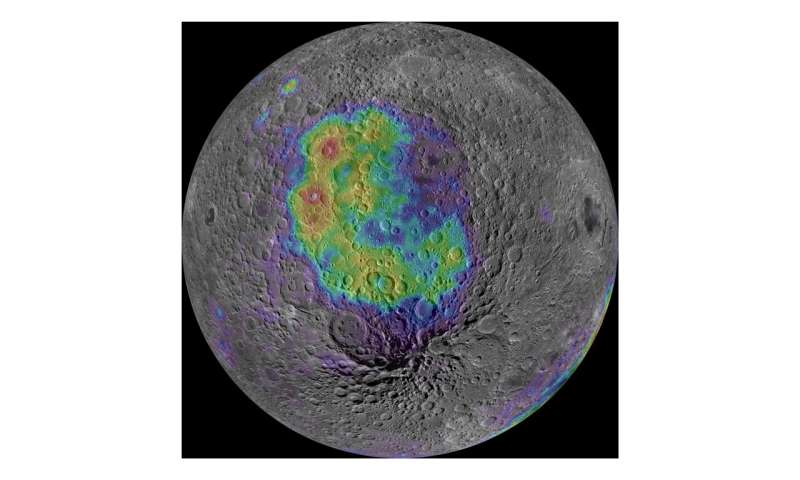Shortly after it formed, the moon was covered in a global ocean of molten rock (magma). As the magma ocean cooled and solidified, dense minerals sank to form the mantle layer, while less-dense minerals floated to form the surface crust. Later intense bombardment by massive asteroids and comets punched through the crust, blasting out pieces of mantle and scattering them across the lunar surface.
Recently, a pair of NASA studies identified the most likely locations to find pieces of mantle on the surface, providing a map for future lunar sample return missions such as those under NASA's Artemis program. If collected and analyzed, these fragments from deep within the moon can provide a better understanding of how the moon, the Earth, and many other solar system worlds evolved.
"This is the most up-to-date evaluation of the evolution of the lunar interior, synthesizing numerous recent developments to paint a new picture of the history of the mantle and how and where it may have been exposed on the lunar surface," said Daniel Moriarty of NASA's Goddard Space Flight Center, Greenbelt, Maryland and the University of Maryland, College Park.
Magma oceans evolve as they cool down and dense materials sink while light materials rise. The formation of magma oceans and their evolution are thought to be common processes among rocky planets and moons throughout our solar system and beyond. Earth's moon is the most accessible and well-preserved body to study these fundamental processes.
"Understanding these processes in more detail will have implications for important follow-up questions: How does this early heating affect the distribution of water and atmospheric gases of a planet? Does water stick around, or is it all boiled away? What are the implications for early habitability and the genesis of life?" adds Moriarty, lead author of the papers, published August 3 in Nature Communications and January 2021 in the Journal of Geophysical Research.
Large rocky objects such as planets, moons, and large asteroids can form magma oceans with the heat generated as they grow. Our solar system formed from a cloud of gas and dust that collapsed under its own gravity. As this happened, dust grains smacked into each other and stuck together, and over time this process snowballed into larger and larger conglomerations, eventually forming asteroid and planet-sized bodies. These collisions generated a tremendous amount of heat. Also, the building blocks of our solar system contained a variety of radioactive elements, which released heat as they decayed. In larger objects, both processes can release enough heat to form magma oceans.
However, the details of how magma oceans evolve as they cool and how the various minerals in them crystalize are uncertain, which affects what scientists think mantle rocks may look like and where they could be found on the surface.
"The bottom line is that the evolution of the lunar mantle is more complicated than originally thought," said Moriarty. "Some minerals that crystallize and sink early are less dense than minerals that crystallize and sink later. This leads to an unstable situation with light material near the bottom of the mantle trying to rise while heavier material closer to the top descends. This process, called 'gravitational overturn," does not proceed in a neat and orderly fashion, but becomes messy, with lots of mixing and unexpected stragglers left behind."
The team reviewed the most recent laboratory experiments, lunar sample analysis, and geophysical and geochemical models to develop their new understanding of how the lunar mantle evolved as it cooled and solidified. They used this new understanding as a lens to interpret recent observations of the lunar surface from NASA's Lunar Prospector and Lunar Reconnaissance Orbiter spacecraft, and NASA's moon Mineralogy Mapper instrument on board India's Chandrayaan-I spacecraft. The team generated a map of likely mantle locations using moon Mineralogy Mapper data to assess mineral composition and abundance, integrated with Lunar Prospector observations of elemental abundances, including markers of the last remaining liquid at the end of lunar magma ocean crystallization, and imagery and topography data from Lunar Reconnaissance Orbiter.
At around 1,600 miles (about 2,600 kilometers) across, the South Pole—Aitken basin is the largest confirmed impact structure on the moon, and therefore is associated with the deepest depth of excavation of all lunar basins, so it's the most likely place to find pieces of mantle, according to the team.
For years, scientists have been puzzled by a radioactive anomaly in the northwest quadrant of the South Pole—Aitken Basin on the lunar farside. The team's analysis demonstrates that the composition of this anomaly is consistent with the "sludge" that forms in the uppermost mantle at the very end of magma ocean crystallization. Because this sludge is very dense, scientists have previously assumed that it should completely sink into the lower mantle early in lunar history.
"However, our more nuanced understanding from recent models and experiments indicates that some of this sludge gets trapped in the upper mantle, and later excavated by this vast impact basin," said Moriarty. "Therefore, this northwest region of the South Pole—Aitken Basin is the best location to access excavated mantle materials currently on the lunar surface. Interestingly, some of these materials may also be present around the proposed Artemis and VIPER landing sites around the lunar South Pole."
Explore further
D. P. Moriarty et al, Evidence for a Stratified Upper Mantle Preserved Within the South Pole‐Aitken Basin, Journal of Geophysical Research: Planets (2020). DOI: 10.1029/2020JE006589



